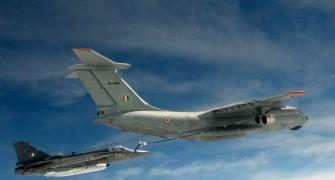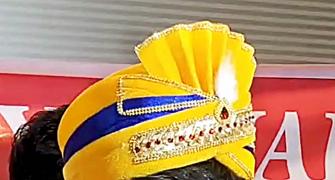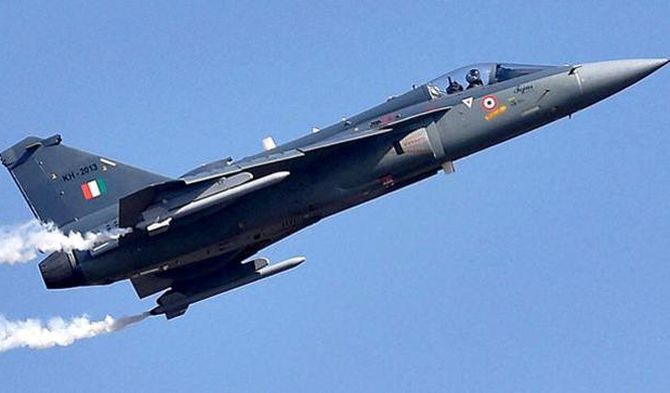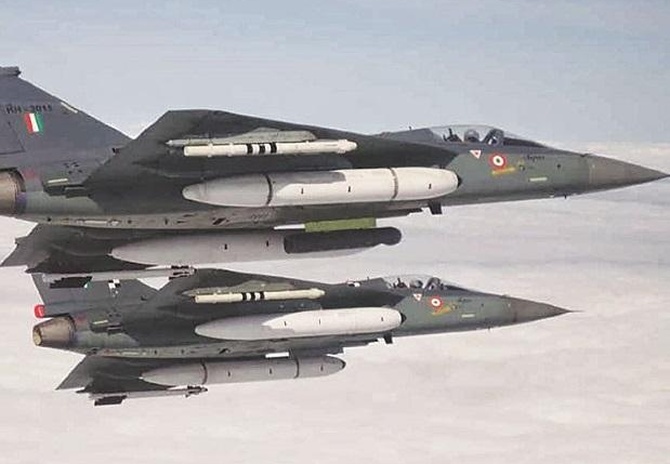The IAF has demanded five new capabilities in the Mark 1A that would give it a clear combat edge over Pakistan's entire fighter fleet, and most of China's as well.
Ajai Shukla reports.

After months of negotiations, the Indian Air Force and the Hindustan Aeronautics Ltd have fixed the price of the Tejas Mark 1A light combat aircraft at about Rs 310 crore (Rs 3.1 billion) per fighter, say ministry of defence sources involved in the negotiations.
HAL is now awaiting a formal contract worth some Rs 26,000 crore (Rs 260 billion) to build 83 Tejas Mark 1A fighters that the MoD has already green-lighted for purchase.
According to the agreed schedule, delivery of the Mark 1A will begin 36 months after the contract date.
If the order is placed at the start of 2020, Tejas Mark IA deliveries will start in 2023.
With 16 fighters to be delivered each year it would take another five years to deliver all 83 fighters-- that is by 2028.
"='We should be signing the contract very soon,' Air Chief Marshal Rakesh Kumar Singh Bhadauria, chief of the air staff, had said on October 4.
That is now imminent.
Girish Deodhare, chief of the Aeronautical Development Agency -- the Defence R&D Organisation agency responsible for the Tejas programme -- spoke exclusively about the Tejas Mark 1A fighter.
He described it as a bridge between the current Tejas Mark 1 and the Mark 2 fighter that ADA is developing.
He says the latter will be, from the standpoint of size, sophistication and capability, far superior to the Mark 1 fighter.
While the Mark 1A light fighter will have the same fuselage and General Electric F-404 engine as the Mark 1, the Mark 2 will be a significantly larger medium fighter with the more powerful GE F-414 engine.
"Initially, the Tejas Mark 2 was planned to be just a re-engined Mark 1 (with a more powerful engine). However, with the advent of the Mark 1A, it was decided that Tejas Mark 2 would be configured with significantly higher capabilities," says Deodhare.
"While the 'all up weight' (maximum take-off weight, with fuel and weapons) of Tejas Mark 1 is 13.5 tonnes, the Mark 2 will be 17.5 tonnes, taking it into the medium weight category.
It will also carry an 85 per cent higher weapons load," explains Deodhare.
While he ADA is developing the Mark 2 fighter, HAL is building the Mark 1A, with ADA contributing its expertise in avionics, flight controls, aerodynamics and structural analysis.
While the Tejas Mark 2 will be almost a generation ahead of the Mark 1 fighter, even the interim Tejas Mark 1A will be far more capable.
The IAF has demanded five new capabilities in the Mark 1A, including 'active electronic scanned array' (AESA) radar, with multi-tasking capability that would give it a clear combat edge over Pakistan's entire fighter fleet, and most of China's as well.
"The initial batches of the Tejas Mark 1A may field an imported AESA radar, but the DRDO is developing its indigenous Uttam AESA radar. As soon as it is proven, the Uttam will start equipping the Tejas Mark 1A," says Deodhare.
The Uttam AESA radar is already flying on a Tejas prototype and has completed 11 successful test flights.
"We need to do a couple of more years of flight testing before it is certified and ready for production. Thereafter, all Tejas Mark 1A will incorporate the indigenous radar," says Deodhare.
This incremental approach is also evident in the 'digital flight control computer' (DFCC) -- a fighter aircraft's brain -- that ADA has designed and qualified for the Tejas Mark 2.
The upgraded DFCC is ready and qualified, but it could not go into the Mark 1A because it was built bigger to allow easier maintenance access in the larger Mark 2 fighter.
"We took the upgraded cards from the Tejas Mark 2's DFCC and installed them into the smaller Mark 1 DFCC chassis, effectively upgrading it for the Mark IA. The new Mark 1A DFCC will have significantly higher processing power allows us to add many more advanced capabilities in the FCS," says Deodhare.
In addition, the Tejas Mark IA is being upgraded with a "self-protection jammer" (SPJ), also supplied by Elta, which the IAF has demanded in order to confuse incoming missiles.
Each Mark 1A fighter will carry a SPJ on a pod under its wing, sharing a mounting station with an air-to-air missile.
Giving the Tejas Mark 2 the contemporary look of the Rafale and Eurofighter, it will be built with canards on the front of the fuselage.
These fin-like structures serve to make the aircraft unstable, and therefore more manoeuvrable.
Deodhare says the ADA decided to fit canards after discovering that increasing the Mark 2's internal fuel capacity to 3,300 kilogrammes (from 2,400 kg in the Mark1) made the fighter excessively stable.
Designing canards near the nose of the aircraft regained its manoeuvrability.
"We are targeting the first flight of the Tejas Mark 2 by 2023. We are confident of this since most of the technologies that will go into it are already matured through the LCA Mark 1," says Deodhare.
Ajai Shukla, one of India's leading defence writers, is a frequent contributor to Business Standard.












